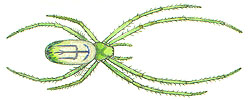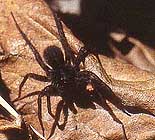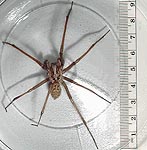 |
|
| You Are Here: Burke Museum : Spider Myths : House : Wolf Spiders |
House Spider Myths
Myth: Those large, hairy spiders I find in my house are wolf spiders.
 |
 |
| Wolf spider Pardosa vancouveri (from a photo by Rod Crawford) Click image to enlarge |
Giant house spider Tegenaria gigantea (from a photo by Chad Marsh) Click image to enlarge |
Fact: Many people have heard the term "wolf spider"
but very few know what it really means. There is a natural tendency to equate
"wolf" with "big and hairy." However, true wolf spiders (species of the family
Lycosidae) are placed in that family by the arrangement
of their eyes, and not by general appearance.
Most wolf spider species are relatively small, their bodies around 1 centimeter
long or less. What's more, in North America no member of the wolf spider family
is part of the house spider fauna. Evidently their type of prey capture (active
pursuit) works better outdoors.
Large, conspicuously hairy, active spiders found indoors are most often males
of the European House Spider group (genus Tegenaria). Incidentally, North
American wolf spiders are not dangerous to humans.
Myth: Spiders in the home are a danger to children and pets.
Fact: House spiders prey on insects and other
small creatures. They are not bloodsuckers, and have no reason to bite a human
or any other animal too large for them to eat. In any interaction between spiders
and larger creatures like humans, the spiders are almost always the ones to
suffer. It is so rare for spiders to bite humans that in a 30-year career of
handling tens of thousands of live spiders, I personally have been bitten twice.
Both bites had only trivial effects.
A person who is not an arachnologist would not likely be bitten more than once
or twice in a lifetime. ("Mystery bites" which people
thoughtlessly blame on spiders, don't count! There are no invisible spiders...).
Very, very few spider species have venom that can harm humans, dogs, or cats.
In most parts of the world, no spiders with medically significant venom have
much chance of being found in houses. In the few areas that are an exception
to this rule, the harmless house spider species still greatly outnumber the
more toxic ones. And spiders whose venom happens to be more toxic to us, are
no more likely to bite us on that account; they are unaware of our existence.
Why, why do people waste their time worrying about spiders? It is not spiders
that are dangerous to your children; the dangerous ones are other humans!
| Previous Myth | Myths Home | Web Resources | Next Myth |
 |
Text ©
2003, Burke Museum of Natural History & Culture, University of Washington, Box 353010, Seattle, WA 98195, USA Phone: 206-543-5590 Photos © as credited |
Queries
to Spider Myths author, Rod Crawford This page last updated 2 September, 2010 This site best viewed at 800 x 600 using IE 5.0 or above. |